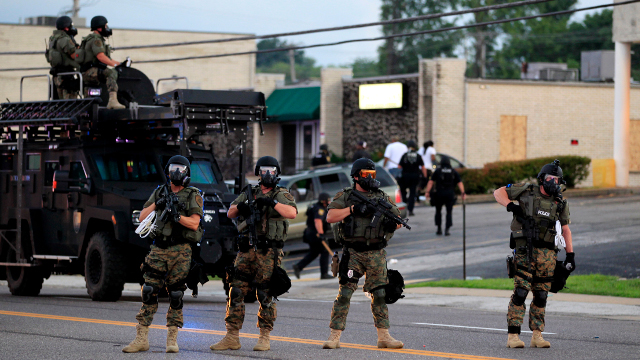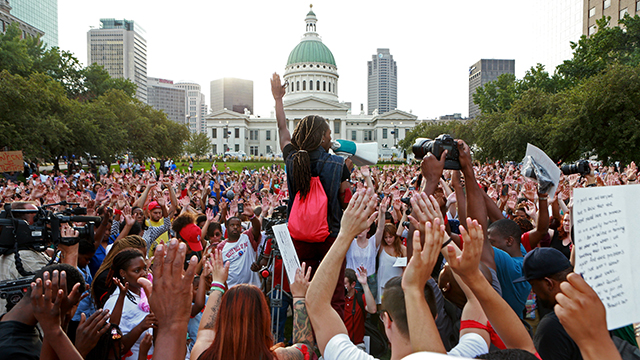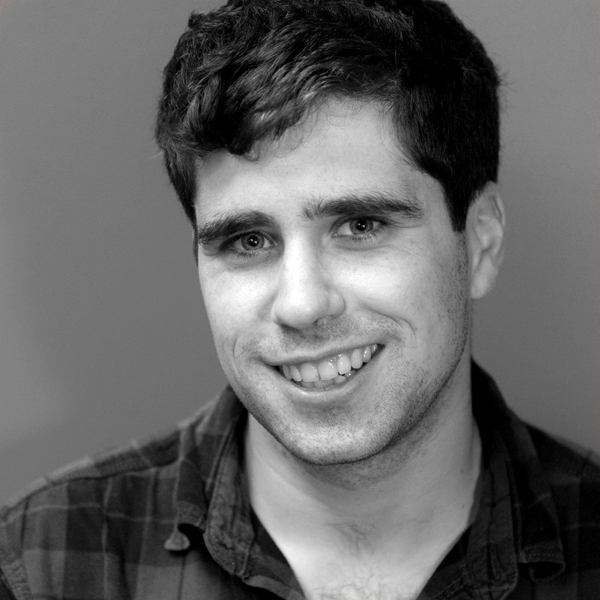
After nearly two weeks, the outrage in Ferguson appears to be taking new forms, and becoming less openly confrontational. But the shooting of Michael Brown — along with a number of similar, troubling, fatal incidents in which a police officer’s overreaction ended in a black man’s death — have started a nationwide conversation about race, class and the nature of American law enforcement.
Here are a few discussions that are emerging as America takes a step back:
1. Ferguson is part of a long history of racial discrimination
The shooting of Michael Brown may have been the spark that ignited a powder keg, but the protests were in response to a legacy of racial injustice in St. Louis’ segregated suburbs, and, more broadly, in America on the whole.
At Marginal Revolution, Alex Tabarrok calls the system described in the report a modern-day “debtors prison.” At the LA Times, Michael Hiltzik notes that before being shot, Michael Brown was, ostensibly, stopped for the most minor of offenses: jaywalking.
Ta-Nehisi Coates writes in The Atlantic that the prejudices shown here are not specific to Ferguson, nor to police officers. “Black people,” he writes “are not above calling the police—but often we do so fully understanding that we are introducing an element that is unaccountable to us. We introduce the police into our communities, the way you might introduce a predator into the food chain. This is not the singular, special fault of the police. The police are but the tip of the sword wielded by American society itself.” And in a sometimes humorous but mostly sobering summary of the first week’s events, John Oliver calls out Ferguson Mayor James Knowles for claiming that the town had no history of racial tensions: “As a general rule, the mayor should not be able to say, ‘There is no history of racial tension here,’ because that sentence has never been true anywhere on earth.”
2. A militarized police force is a scary thing
In an editorial titled “Overkill,” The Economist quotes Gene O’Donnell of the John Jay College of Criminal Justice: “It is hard to point to anything that Ferguson police did [since Mr Brown’s shooting] that was not wrong.” Among these blunders was the over-the-top and ham-handed show of miltary might by the mostly white officers in a majority black town. “They confronted peaceful demonstrators and rioters alike with a stunning show of force—armored cars with snipers on top—and precious little tact,” the editorial board writes. At BillMoyers.com, Iraq War veteran Rafael Noboa y Rivera writes that Ferguson police were better armed than his men were in a war zone, and used confrontational tactics that the military is trained to avoid when attempting to de-escalate a protest.
It’s not just Ferguson, Alex Kane warns. “The weapons that destroyed Afghanistan and Iraq have made their way to local law enforcement,” he writes. “It is harming civil liberties, ramping up the ‘war on drugs,’ impacting the most marginalized members of society and transforming neighborhoods into war zones.” And Paul Waldman notes that there are limits to what the federal government can do to remedy the situation: “Congress could turn off the spigot that pours this equipment into these communities, but unless the federal government starts repossessing the equipment it already distributed (highly unlikely, to say the least), police departments all over the country will still be awash in military gear.” But Waldman hopes that the consensus among police chiefs nationwide is that Ferguson is exhibit A of what not to do: Maybe “some of those police chiefs will examine their own policies, when it comes to both using that equipment and dealing with crowds of protesters. Ferguson surely won’t change everything. But it might be a start.”

Police wearing riot gear try to disperse a crowd Monday, Aug. 11, 2014, in Ferguson, Missouri.
3. Do we talk about race or do we talk about class?
Race is a key factor, but the unrest in Ferguson is also a window into America’s class conflict, argues Kareem Abdul-Jabbar, the retired basketball legend, in Time Magazine. He writes that framing Brown’s death and the protests that followed as a racial struggle will start a series of debates that are less relevant than the one we should be having: How the majority can reclaim democracy from the rich few who hold the reigns.
He writes:
This fist-shaking of everyone’s racial agenda distracts America from the larger issue that the targets of police overreaction are based less on skin color and more on an even worse Ebola-level affliction: being poor. Of course, to many in America, being a person of color is synonymous with being poor, and being poor is synonymous with being a criminal….
So, it’s crucial that those in the wealthiest One Percent keep the poor fractured by distracting them with emotional issues like immigration, abortion and gun control so they never stop to wonder how they got so screwed over for so long.
Noting that there’s “so much good” in Abdul-Jabbar’s treatment of the topic, Nation sports editor Dave Zirin takes issue with one of Jabbar’s central arguments. Racism is the key discussion here, writes Zirin. “Michael Brown was shot dead by the police because he is black,” he argues. “Fighting racism, sexism and anti-LGBT bigotry is not a distraction from building a united struggle but a precondition for building a united struggle.”
4. Ferguson shows that “small,” close-to-home government isn’t necessarily best
Paul Waldman writes for The Washington Post’s Plumline blog that, although liberals and libertarians were horrified at the show of military-style police force in Ferguson, the conflict demonstrates that sometimes, the best government isn’t that which is small and close at hand. He writes:
Local government, the one that’s supposed to be in touch with the people, is not only out of touch, it’s making their lives miserable. The events in Ferguson have also shown us a case of inept local government that has made the situation worse at every turn. First the Ferguson police responded to protesting residents like they were retaking Fallujah. Then when state troopers succeeded in calming things down for a night — a higher level of government trying to correct the failures of a lower level — the Ferguson police released the surveillance video from that convenience store, as though trying to make the case that Michael Brown had it coming, which enraged local residents and started a new cycle of unrest….
The next time you hear someone say that power should be devolved as far as possible to the state and local level, remember that those lower levels of government are often where the worst problems are.
5. Is the press under attack?
Roughly a dozen members of the press were arrested while covering the protests in Ferguson. Ryan Devereaux of The Intercept, Aaron Ernst of Al Jazeera, Wesley Lowery of The Washington Post and Ryan Reilly of The Huffington Post each published accounts of their run-ins with aggressive police officers; three of the four spent time in jail. Noting that the threat to the press extends beyond Ferguson, to government prosecution of journalists like James Risen who publish leaks without revealing their source, John Nichols writes, “There has to be a consistent and absolute defense of the rights not just of high-profile national reporters but of all journalists and all citizens who gather information, demand answers, speak truth to power and then seek to disseminate their reports.”

Jay Mitchell, of Pagedale, Missouri, speaks and solicits a response of hands in the air from the crowd Thursday, Aug. 14, 2014, in St. Louis during a peace vigil and moment of silence for Michael Brown. (AP Photo/St. Louis Post-Dispatch, Christian Gooden)
6. Is it time for the next civil rights movement?
At The New Yorker, Jelani Cobb notes that what’s happening in Ferguson bears resemblance to the start of a movement. “More than one person in the streets of Ferguson has compared what is happening here to the chaotic days of the Birmingham desegregation campaign in 1963,” Cobb writes. “And, like that struggle, the local authorities, long immune to public sentiment, were incapable of understanding how their actions reverberated outside the hermetic world where they held sway—how they looked to the world.”
At The Nation, Deepa Iyer writes that it is important for all communities of color to stand in solidarity with the protestors in Ferguson: “Latinos and Asian and Arab-Americans are no strangers to police violence and profiling based on skin color, accent, language, immigration status and faith.”
But, at The Root, Tufts historian Peniel E. Joseph writes that, unlike a half-century ago, black youth today don’t identify with any particular civil rights leader. “America’s racial underclass… rarely sees political leaders of any color advocating for them,” he writes. And former New York Times columnist Bob Herbert writes for the think tank Demos that movements are inhibited by how quickly Americans forget. Incidents that expose racism and poverty crop up periodically, but then poor black people fade “back into the invisibility from which they had come … Now, because of the persistence of racism and a relaxation of the fight against it, we are moving backwards. Ferguson is just the latest illustration.”
He concludes:
What is needed right now is a national gathering of some of the brightest and most committed African-American men and women to begin devising strategies to fight back in a coherent and sustained way against the racial injustice that still permeates this society. Let that be the first step toward the development of a new cadre of black leadership to carry this fight forward.


